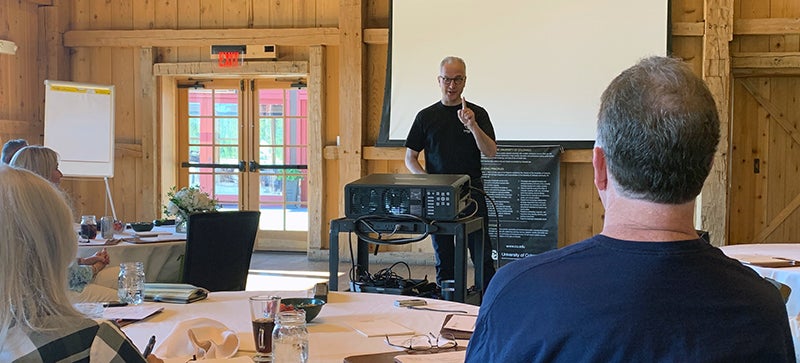The Fourth Industrial Revolution: What will it mean for CU?
The Fourth Industrial Revolution will have profound impacts on society and particularly on higher education, and how the University of Colorado responds will be critical to its future, the CU Board of Regents heard during a presentation at its retreat in Tabernash on July 12.
The first industrial revolution was powered by steam, followed by electricity, then computing. The fourth involves an amalgam of artificial intelligence, 3-D printing, biotechnology, robotics, autonomous vehicles, nanotechnology, quantum computing and the internet of things.
“You should be excited and you should be really worried,” Vice President for Academic Affairs Michael Lightner told the board. “The standard model is being dramatically disrupted.”
Lightner joined President Mark Kennedy and Vice President for Finance and Chief Financial Officer Todd Saliman for the tag-team presentation.
The technological revolution that is already well underway will combine with demographic shifts to rock the foundations of higher education, Kennedy said.
“I’d rather us be a rocker than a rockee,” he said. “This is revolutionary.”
Automation is expected to have a significant impact on the labor market, with some estimates predicting it could displace up to 44% of U.S. jobs by 2030. The issue was spotlighted when, on the morning the regents met, Amazon announced it would spend $700 million to retrain one-third of its workforce.
CU has some good examples of how it is moving into the future, Lightner said, including the CUbit quantum initiative at CU Boulder and the Personalized Medicine data project at CU Anschutz. Yet the university needs to maintain a sharp focus, he said.
Societal disruptions will require more production of bachelor’s degrees, as well as different kinds of credentials. But those come along with their own challenges, including perennially low state funding, the greater expense to produce STEM degrees and the need for more student services.
Saliman told the regents the good news is that CU has maintained strong enrollment on its campuses, but noted that the bulk of enrollment increases since 2009 have come from Pell-eligible students and those from underrepresented minorities. Those student populations require more financial aid and more student support services, which will drive up costs. Additionally, the number of Colorado high school graduates is expected to peak by 2025, which will lead to more competition for students.
“We’re not meeting documented need now, and we’re going to have to be serving more students who have more need,” Saliman said.
To do so, Saliman said, CU will need to focus on multiple paths, including more efficiencies, restoring state funding, reviewing tuition pricing structures, increasing nonresident students while maintaining resident share, and identifying new revenue sources.
Kennedy said CU needs to look to new models to keep up with the shifting sands of technology and demographics. He suggested CU needs a more robust online strategy, to move toward adaptive learning and to consider stackable certificates that add up to a degree.
Regent Irene Griego said the trends are precisely why CU needs to engage in systemwide strategic planning.
“When we look at our strategic planning in the next three to five years, all this should be included in what we do,” she said.
Kennedy agreed. “Our strategic plan has to dive into these issues, wrestle with them and come up with an approach,” he said.
In other business at the board’s retreat, the regents heard about the presidential transition from Senior Vice President and Chief of Staff Leonard Dinegar. He said Kennedy has visited all four campuses several times, met with governance groups, engaged with donors and traveled to Washington, D.C., where he met with all but one member of Colorado’s Congressional delegation.
“It’s like building a foundation for his presidency, and it’s been a busy, fast start for Mark,” Dinegar said.
Kennedy started June 17 and officially became president July 1. He told the regents he has had a busy month.
“My goal has been to listen, learn and meet as many people as possible,” Kennedy said. “I’ve had some great meetings so far and look forward to great meetings in the future.”
The board also heard from Vice President for Communication Ken McConnellogue, who outlined plans to bolster CU’s outreach and engagement activities in Colorado and beyond.
While the president’s office and campuses engage in various outreach activities, he said efforts were disconnected and, in some cases, had declined. Challenges include addressing negative public perceptions about higher education, increased competition for students, meeting state needs, and changes to demographics and technology.
McConnellogue told the regents the plan is to create an office of engagement and outreach that would spearhead visits to communities around Colorado and nationally, while also coordinating with campus efforts. It would target prospective students and parents, elected officials, business and community leaders, alumni and donors, and K-12 schools and other higher education institutions. The plan also includes creating a lecture series that would feature CU faculty, as well as national experts. The lectures would be on campuses and at other sites throughout Colorado.
The outreach effort also includes managing advisory boards made up of people internal and external to the university who will advise the president and administration on selected topics.
Outcomes from the outreach and engagement efforts are expected to include consistent, sustainable relationships around Colorado and beyond, improved perceptions of the value and affordability of public higher education, enhanced student recruitment, stronger legislative relations, increased possibilities for public-private partnerships, and a better understanding of state needs.


